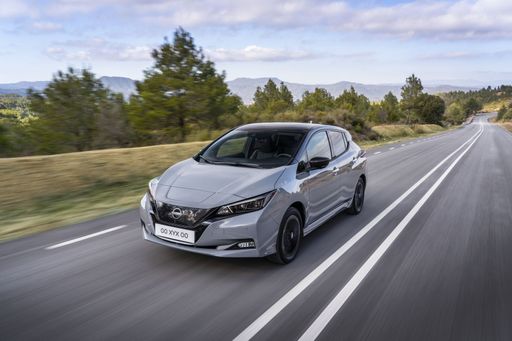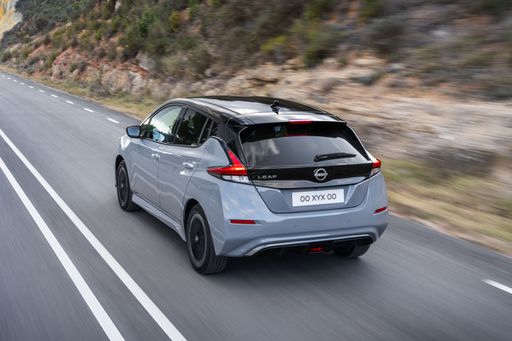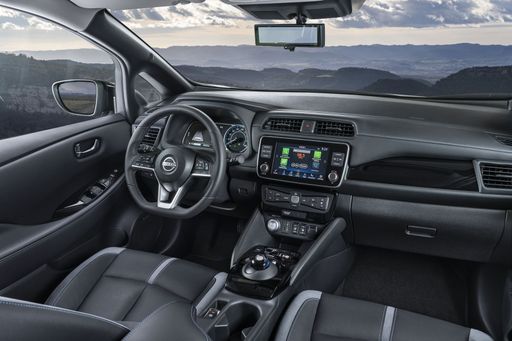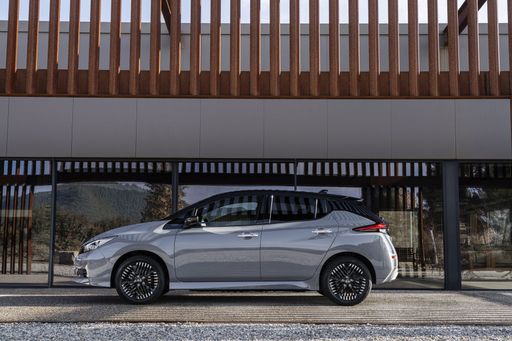Mazda 3 Sedan vs Nissan Leaf – Differences & prices compared
Compare performance, boot space, consumption and price in one view.
Find out now: which car is the better choice for you – Mazda 3 Sedan or Nissan Leaf?
The Mazda 3 Sedan (Sedan) comes with a Petrol MHEV engine and Manuel or Automatic transmission. In comparison, the Nissan Leaf (Hatchback) features a Electric engine with Automatic transmission.
When it comes to boot capacity, the Mazda 3 Sedan offers 450 L, while the Nissan Leaf provides 394 L – depending on how much space you need. If you’re looking for more power, decide whether the 186 HP of the Mazda 3 Sedan or the 217 HP of the Nissan Leaf suits your needs better.
In terms of consumption, the values are 5.50 L per 100 km for the Mazda 3 Sedan, and 16.70 kWh for the Nissan Leaf.
Price-wise, the Mazda 3 Sedan starts at 25000 £, while the Nissan Leaf is available from 30800 £. Compare all the details and find out which model fits your lifestyle best!
Mazda 3 Sedan
The Mazda 3 Sedan stands out with its elegant and sleek design, capturing attention on the road with its refined aesthetics. Inside, it offers a well-crafted and comfortable cabin, providing a pleasurable driving experience marked by quality materials and advanced features. The car's performance is reliable and smooth, making it a versatile choice for both city driving and long-distance journeys.
detailsNissan Leaf
The Nissan Leaf stands out as a pioneering model in the realm of electric vehicles, known for its impressive blend of practicality and eco-friendliness. It offers a smooth and quiet driving experience, making it an ideal choice for city commuting and longer journeys alike. The interior design is both comfortable and intuitive, providing drivers with a sense of modernity and ease of use.
details @ germany.nissannews.com
@ germany.nissannews.com
 @ germany.nissannews.com
@ germany.nissannews.com
 @ germany.nissannews.com
@ germany.nissannews.com
 @ germany.nissannews.com
@ germany.nissannews.com

|
|
|
|
|
Costs and Consumption |
|
|---|---|
|
Price
25000 - 34200 £
|
Price
30800 - 37200 £
|
|
Consumption L/100km
5.5 - 6.1 L
|
Consumption L/100km
-
|
|
Consumption kWh/100km
-
|
Consumption kWh/100km
16.7 - 17.8 kWh
|
|
Electric Range
-
|
Electric Range
270 - 385 km
|
|
Battery Capacity
-
|
Battery Capacity
39 - 59 kWh
|
|
co2
123 - 135 g/km
|
co2
0 g/km
|
|
Fuel tank capacity
51 L
|
Fuel tank capacity
-
|
Dimensions and Body |
|
|---|---|
|
Body Type
Sedan
|
Body Type
Hatchback
|
|
Seats
5
|
Seats
5
|
|
Doors
4
|
Doors
5
|
|
Curb weight
1420 - 1492 kg
|
Curb weight
1580 - 1756 kg
|
|
Trunk capacity
450 L
|
Trunk capacity
385 - 394 L
|
|
Length
4660 mm
|
Length
4490 mm
|
|
Width
1795 mm
|
Width
1788 mm
|
|
Height
1440 mm
|
Height
1540 - 1545 mm
|
|
Payload
467 - 481 kg
|
Payload
384 - 415 kg
|
Engine and Performance |
|
|---|---|
|
Engine Type
Petrol MHEV
|
Engine Type
Electric
|
|
Transmission
Manuel, Automatic
|
Transmission
Automatic
|
|
Transmission Detail
Manual Gearbox, Automatic Gearbox
|
Transmission Detail
Reduction Gearbox
|
|
Drive Type
Front-Wheel Drive
|
Drive Type
Front-Wheel Drive
|
|
Power HP
140 - 186 HP
|
Power HP
150 - 217 HP
|
|
Acceleration 0-100km/h
8.1 - 9.8 s
|
Acceleration 0-100km/h
6.9 - 7.9 s
|
|
Max Speed
203 - 216 km/h
|
Max Speed
144 - 157 km/h
|
|
Torque
238 - 240 Nm
|
Torque
320 - 340 Nm
|
|
Number of Cylinders
4
|
Number of Cylinders
-
|
|
Power kW
103 - 137 kW
|
Power kW
110 - 160 kW
|
|
Engine capacity
1998 - 2488 cm3
|
Engine capacity
-
|
General |
|
|---|---|
|
Model Year
2025
|
Model Year
2019
|
|
CO2 Efficiency Class
D
|
CO2 Efficiency Class
A
|
|
Brand
Mazda
|
Brand
Nissan
|
Mazda 3 Sedan
Introduction to the Mazda 3 Sedan
Unveiling the 2024 Mazda 3 Sedan, a vehicle that gracefully combines elegance with innovation. This model is an exemplar of Mazda's commitment to pushing the boundaries of design and performance. The Mazda 3 Sedan is available with a choice of engines that blend efficiency with power, ensuring a drive that's as rewarding as it is economical.
Advanced Powertrains
The heart of the Mazda 3 Sedan lies in its cutting-edge engine options. Equipped with a 2.0-litre e-SKYACTIV-X engine, this sedan delivers up to 186 PS while maintaining excellent fuel efficiency. For those seeking a balance between power and efficiency, the e-SKYACTIV-G engine with 140 PS is an ideal choice. Both engines utilize mild-hybrid technology, enhancing performance and reducing emissions.
Efficiency Meets Performance
Boasting an impressive fuel consumption range between 5.5 to 6.1 L/100km, the Mazda 3 Sedan is perfect for both city commutes and long drives. With emissions rated at 123 to 135 g/km, it strikes a sustainable balance without compromising on performance. Acceleration from 0 to 100 km/h takes just 8.1 seconds with the most powerful variant, highlighting its agile character.
Specifications and Pricing
From the entry-level Center-Line to the luxurious Takumi trim, the Mazda 3 Sedan offers a range of equipment lines catering to a variety of tastes and needs. The pricing is competitive, starting from €28,640 and reaching up to €39,390, offering remarkable value for a car of this class. Monthly costs range between €961 to €1080, reflecting its economic viability.
Design and Comfort
The Mazda 3 Sedan’s dimensions (4,660 mm in length, 1,795 mm in width, and 1,440 mm in height) create a sleek profile that underscores its sophisticated design philosophy. Inside, the cabin is spacious, comfortably accommodating five passengers, while the boot offers a practical 450 litres of luggage space, ideal for both daily tasks and longer trips.
Innovative Technology and Features
The Mazda 3 Sedan impresses with a suite of advanced technologies, enhancing safety and convenience. Front-wheel drive ensures stability and control, while advanced driver assistance systems provide support during challenging driving conditions.
Concluding Thoughts
The 2024 Mazda 3 Sedan represents a harmonious blend of performance, efficiency, and modern technology. Its stylish design and innovative features make it a compelling choice for those seeking a sophisticated and reliable sedan. Whether you're after a manual transmission for a more engaged driving experience or the convenience of an automatic, the Mazda 3 Sedan delivers on all fronts.
Nissan Leaf
Introduction to the Nissan Leaf: A Pioneer in Electric Mobility
The Nissan Leaf has established itself as a trailblazer in the realm of electric vehicles (EVs) since its launch. As we delve into its present-day iterations, the Leaf continues to soar in popularity due to remarkable advancements in technology and sustainability. Let's explore what makes the Nissan Leaf a standout in today's automotive market.
Power and Performance: Under the Hood of the Nissan Leaf
The Nissan Leaf boasts a power output ranging from 150 to 217 PS, depending on the battery option chosen. The vehicle's electric motor, a product of cutting-edge engineering, offers instant torque ranging from 320 to 340 Nm, resulting in impressive acceleration capabilities. The 0 to 100 km/h dash is achieved in as little as 6.9 seconds, showcasing its prowess in electric performance.
Battery Technology: Efficient Energy Management
When discussing the Nissan Leaf, battery technology is at the forefront. The available battery capacities range from 39 to 59 kWh, supporting an electric range between 270 to 385 km. This flexibility allows drivers to choose a model that best fits their driving habits, providing peace of mind for longer journeys without frequent recharging.
Sustainability: The Environmental Edge
One of the primary attractions of the Nissan Leaf is its commitment to sustainability. As an all-electric vehicle, it produces zero CO2 emissions, placing it in the top tier of the CO2-efficiency class with an 'A' rating. This clean energy approach contributes significantly to reducing environmental impact and supports Nissan's drive towards a greener future.
Design and Comfort: Aesthetic Appeal and Practicality
The Nissan Leaf is not just about efficiency; it's also designed for comfort and utility. With its sleek hatchback body and dimensions of 4490 mm in length, 1788 mm in width, and a height of up to 1545 mm, it offers ample interior space. The boot capacity ranges from 385 to 394 litres, providing sufficient storage for everyday needs. The model accommodates five passengers comfortably, ensuring a pleasant ride for everyone.
Innovations and Safety: Advanced Features for Peace of Mind
Nissan equips the Leaf with an array of intelligent features that enhance safety and convenience. The available equipment lines, including N-CONNECTA, Tekna, e+ N-CONNECTA, and e+ Tekna, offer varying levels of technology integration. ProPILOT Assist, e-Pedal, and a comprehensive suite of driver-assistance technology are just a few examples that highlight Nissan's commitment to innovation in the EV market.
Conclusion: The Nissan Leaf Continues to Lead
With prices ranging from €35,900 to €43,400, the Nissan Leaf remains an attractive choice for those looking to embrace electric mobility. It perfectly balances performance, design, and sustainability, making it a compelling choice in the competitive EV landscape. The Nissan Leaf not only represents the future of driving but also reinforces why it continues to be a leader in the electric vehicle community.
The prices and data displayed are estimates based on German list prices and may vary by country. This information is not legally binding.
